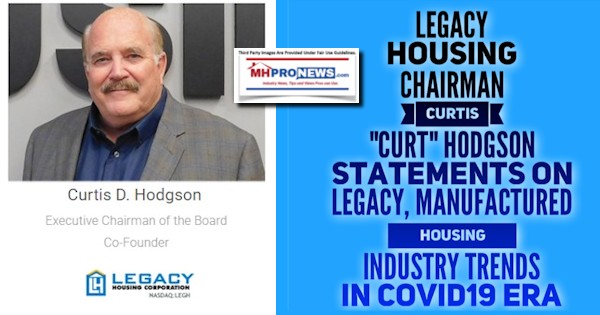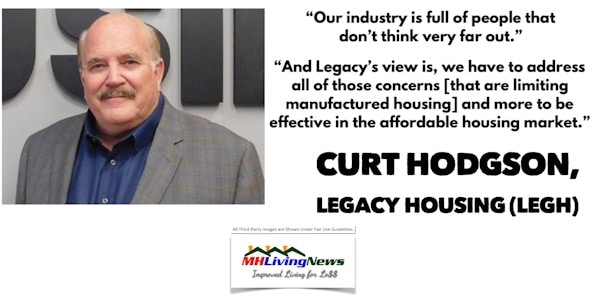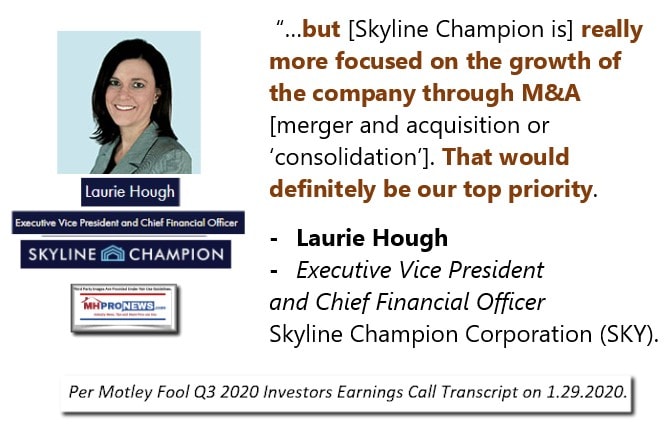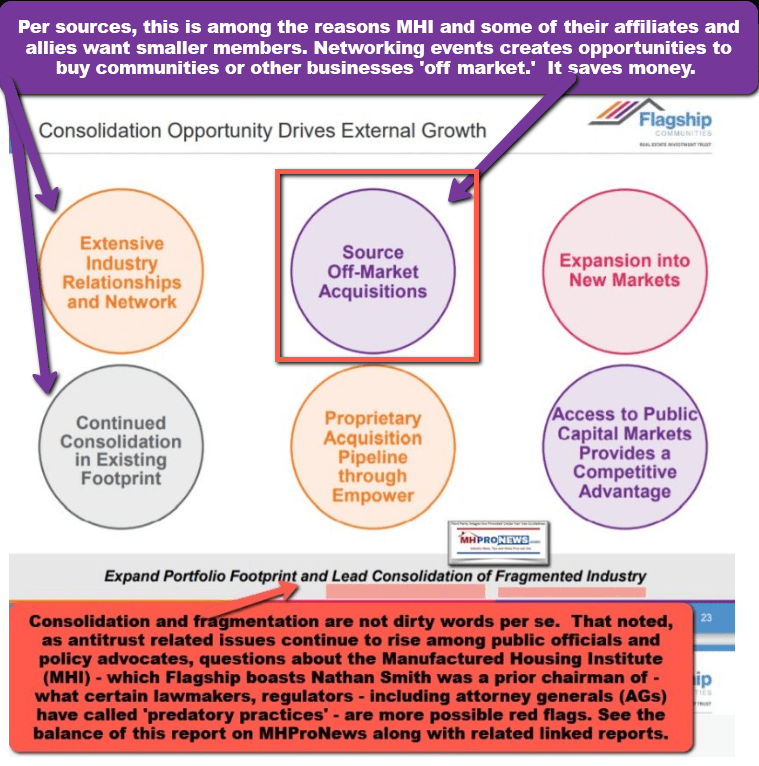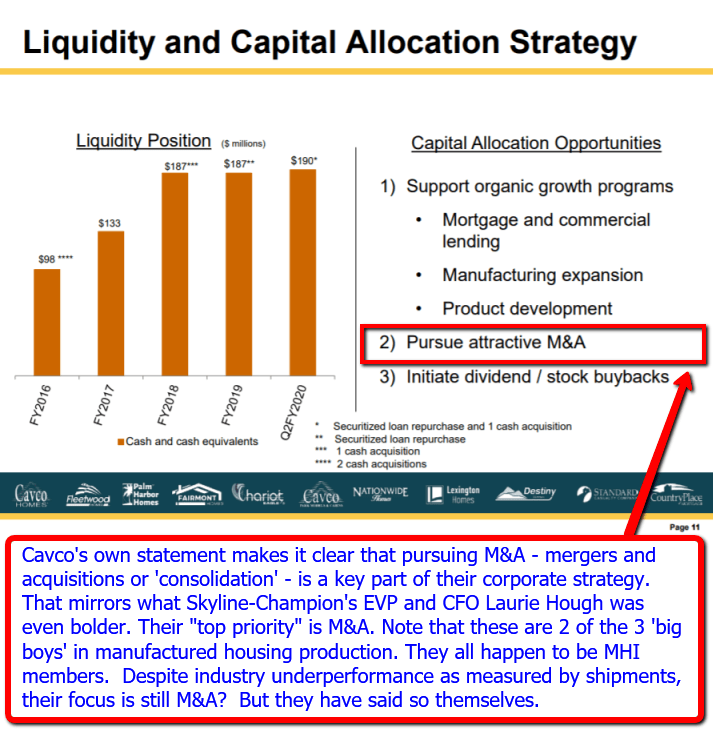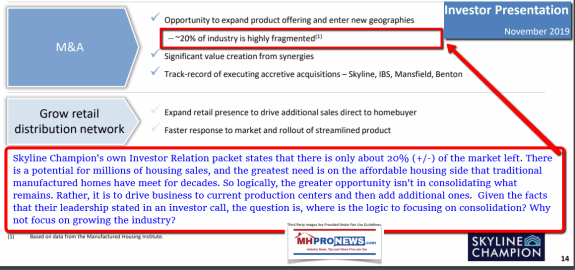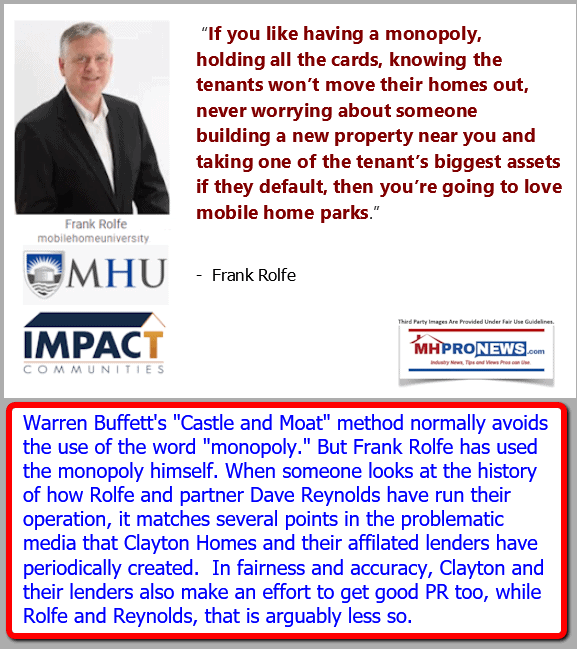The recent Legacy Housing Corporation’s (Nasdaq:LEGH) media release was provided to industry readers and other interested parties in the report linked below.
Days prior to the above, a side-by-side comparison of the view of various analysts that compared Legacy with Skyline Champion was the focus of our evening market report, linked below.
Each of those previous reports provide a useful backdrop to the edited transcript of the November 17, 2020 conference call as reported by Yahoo News and Reuters on November 17, 2020. Minor spacing and obvious edits (e.g.: Midwest vs. midwest) have been made by MHProNews, but otherwise the text below remains unchanged from those as reported by the transcript providers.
Before diving into the Legacy earnings call transcript, a few pull quotes are useful to set the stage for the full report in context.
Against that backdrop, the transcript from Legacy Housing is as follows. MHProNews will provide additional information, analysis and commentary following the transcript.
Edited Transcript of LEGH.OQ earnings conference call or presentation 17-Nov-20 4:00pm GMT

Conference Call Participants ================================================================* Alexander John Rygiel B. Riley Securities, Inc., Research Division – Analyst * Christopher R. Sansone Sansone Advisors, LLC – Managing Partner * Mark Eric Smith Lake Street Capital Markets, LLC, Research Division – Senior Research Analyst ================================================================
Presentation ——————————————————————————– Operator [1] ——————————————————————————–
Ladies and gentlemen, thank you for standing by, and welcome to the Legacy Housing Corporation Third Quarter 2020 Earnings Call. (Operator Instructions) Please be advised that today’s call may be recorded. (Operator Instructions) I would now like to hand the conference over to your speaker today, Curt Hodgson, Executive Chairman of the Board. Please go ahead.
——————————————————————————–
Curtis Drew Hodgson, Legacy Housing Corporation – Co-Founder & Executive Chairman of the Board [2]
——————————————————————————–
Thank you for joining the call today. Before we begin, may I remind the listeners that management’s prepared remarks today will contain forward-looking statements, which are subject to risks and uncertainties, and management may make additional forward-looking statements in response to your questions. Therefore, the company claims the protection of the safe harbor for forward-looking statements that is contained in the Private Securities Litigation Reform Act of 1995. Actual results may differ from management’s current expectations, and therefore, we refer you to a more detailed discussion of the risks and uncertainties in the company’s annual report filed with the Securities and Exchange Commission. In addition, any projections as to the company’s future performance represents management’s estimates as of today’s call. Legacy Housing assumes no obligation to update these projections in the future unless otherwise required by applicable law.
Now let me turn to a discussion of our third quarter performance and provide additional corporate updates. I will then turn the call over to our Chief Financial Officer, Thomas Kerkaert, to discuss the financials in more detail. Overall, we’re pleased with the third quarter results. Net revenue increased to $43.7 million in the third quarter of 2020 compared to $41.9 million in the third quarter of 2019. On a trailing 12-month basis, we have increased net revenue by $11 million or 6.9%. We have also experienced solid improvement in our income from operations for the quarter.
Third quarter 2020 income from operations was $10.8 million compared to $8.1 million for the third quarter last year, up 34.5%. Net income of $8.4 million for the quarter was increased 37.6% from last year. Earnings per share increased as well, expanding from $0.25 per share in the last year to $0.35 per share this year. Looking at the trailing 12 months, Net income is up $9.6 million or 38.9%. We have also continuously increased tangible book value per share, as it has grown from $8.85 per share in the third quarter of last year to now $10.27 per share in the third quarter of this year, a $1.42 per share increase over the last 12 months or 16%.
Looking at the remainder of 2020, overall market demand is good, orders are good, backlog is good, and our loan portfolio book remains strong and is performing well. Interest revenue on the loan portfolio continues to grow.
At the current 12-month run rate interest revenue from loan portfolios will contribute $25.7 million over the next year to our top line.
We are dealing effectively with the fallout from COVID, especially as it impacts manufacturing and production levels.
We have brought on additional labor to increase production and raise prices to address cost increases in the lumber market during the third quarter. We also have subcontracted [Dow Production] up north and the Midwest to meet demand as manufacturing adapts to current constraints. With that, I will now turn it over to our CFO, Tom Kerkaert, to provide additional commentary on the quarter.
——————————————————————————–
Thomas Kerkaert, Legacy Housing Corporation – CFO [3]
——————————————————————————–
Thank you, Curt. Total product sales were $36.6 million for the third quarter compared to $35.4 million for the same period in 2019. As has been the case in recent quarters, sales to manufactured home parks is the largest part of our product sales coming in at $17.7 million for the third quarter. That $17.7 million is 48.4% of total product sales for the quarter compared to 47.7% of total product sales for the same period last year.
Interest revenue has continued to grow as a component of overall net revenue. Total interest revenue of $6.4 million represented 14.7% of net revenue for the third quarter of 2020 compared to $5.7 million or 13.6% of net revenue for Q3 2019.
In particular, the interest revenue from our manufactured home park notes increased 48.8% to over $2.4 million for the third quarter of 2020 from $1.6 million in the third quarter of 2019. Overall, interest revenue was up 13% for the quarter compared to last year.
Interest revenue from the consumer loan portfolio was roughly flat year-over-year. Similarly, the manufactured home park loan portfolio increased by $9.5 million or 7.9% to $129.6 million for the third quarter 2020 compared to $120.1 million for the second quarter of 2020.
Year-over-year, the manufactured home park loan portfolio increased by 58% from $82 million at the end of September 2019. The consumer loan portfolio increased by 1.3% to $108.6 million, inclusive of allowances for loan loss and other discounts, compared to $107.2 million for the second quarter of 2020. Gross margin realized on product sales was 23.9% for the third quarter of 2020, up from 22.2% in the third quarter of 2019, suggesting that our pricing increases and cost mitigation efforts have kept pace with unavoidable cost increases and the cost of disruption from the global health situation.
Product gross margin year-to-date was 26.7%, which is down from 27.6% in 2019. This year-over-year decline has its origins in the health disruptions and the changes to our supply chain, which impacted us most dramatically in the first half of 2020.
The company has seen significant reductions across the board in our SG&A expense. SG&A expense for the third quarter of 2020 was $4.5 million, which is a 28% decrease from $6.3 million in the third quarter of 2019. The realized savings were broad-based and included the cost of salaries and benefits, warranty and delivery costs.
Additionally, our third quarter 2020 loan losses were favorable compared to the prior year as the quality of our notes receivables has held up very well in these otherwise very trying times.
Our operational — or sorry, other operational measures implemented from the start of the COVID-19 pandemic have resulted in about $2.6 million in savings through the end of the third quarter. These reductions are continuing into Q4, and we’re continuing to evaluate what additional measures may be needed on a go-forward basis as situations arise.
Finally, net income increased to $27.5 million for the 9 months ending September 2020 compared to $22 million for the same period last year. This is a 25% increase in net income which we achieved while net revenue has increased 1.9%.
I believe this highlights the efficiency of our cost containment measures. Looking ahead to the fourth quarter, we think the fourth quarter is going to be strong, and we believe it will deliver a good outcome, which is similar to and possibly better than the quarter that we just reported. Curt, that completes our financial report.
——————————————————————————–
Curtis Drew Hodgson, Legacy Housing Corporation – Co-Founder & Executive Chairman of the Board [4]
——————————————————————————–
Thank you, Tom. As I mentioned at the start of the call, we’re pleased with the third quarter and year-to-date financials. We believe the long-term fundamentals of the business and the industry remain strong. We have been proactive and disciplined in configuring the business to confront the impact of COVID. These early actions to reduce SG&A and inventory enhance our flexibility and improve our operational position for the remainder of this year.
I remain positive when I look to the rest of this year, that we will continue to outperform and deliver the kind of value and returns our shareholders come to expect.
At this point, we’ll take any questions you may have.
================================================================
Questions and Answers
——————————————————————————–
Operator [1] ——————————————————————————–
(Operator Instructions) Our first question comes from the line of Alex Rygiel with B. Riley.
——————————————————————————–
Alexander John Rygiel, B. Riley Securities, Inc., Research Division – Analyst [2]
——————————————————————————–
Curt, you’ve seen a fairly active hurricane season this year. How did that impact demand in the third quarter? Or how could it impact demand over the coming quarters?
——————————————————————————–
Curtis Drew Hodgson, Legacy Housing Corporation – Co-Founder & Executive Chairman of the Board [3] ——————————————————————————–
Well, that’s a good question. Our demand is so robust that our real challenge is production and even an increase in demand from the hurricanes that hit particularly in Louisiana isn’t really going to increase business because we’re limited by production capability right now. It’s been the story of the 2 Ls for the third quarter, labor and lumber.
Labor was not as easy to replace as we had hoped after COVID, I guess, in part because of the unemployment benefits that were — that the government shelled out. But — so we weren’t able to get back to pre-COVID production levels in the third quarter.
Now we’re added in December, we’re kind of back to where we were pre-COVID in production.
But even that said, we’re looking at 10-, 12-, 14-week backlogs across the entire industry.
So I’m not really sure the demand is the problem as much as satisfying demand that’s already [in put].
We had our September and October shows. I don’t think other manufacturers did that. We had them live in Texas and in Georgia. And they were the most successful shows from an order point of view that we ever had.
So we did have one customer in Lake Charles, Louisiana, that’s receiving a huge insurance settlement. And he plans on re-upping his orders with us as soon as he gets the settlement. He’s closed now. So I assume that we’ll have an order book from Lake Charles, Louisiana coming up. It will be several hundred units, it looks like. I hope that answered your question, Alex.
——————————————————————————–
Alexander John Rygiel, B. Riley Securities, Inc., Research Division – Analyst [4]
——————————————————————————–
It does. And to sort of follow up on some of that answer. With demand so high, you obviously had some positive response in raising pricing in the third quarter. Has that continued into the fourth quarter?
——————————————————————————–
Curtis Drew Hodgson, Legacy Housing Corporation – Co-Founder & Executive Chairman of the Board [5] ——————————————————————————–
The last price increase we had was announced August 31, kind of at the peak of the lumber run up. It was effective in early September. We haven’t had a price increase since then, but we had a series of price increases in the summertime, along with the rest of the industry. We kind of anticipated the parabolic curve on the way up and lumber would eventually peter out, and it did.
So we didn’t increase our prices as much as some of our competitors did, and we don’t intend to have any price decreases.
I think overall, our price increases for the year have been in the 10% to 15% range, almost entirely due to the 2 Ls, labor and lumber, and we intend to be able to hold our current prices through the rest of the year and maybe even into next year.
But we couldn’t raise prices fast enough because of lumber. It was just incredible. I’ve never seen anything like it before. Lumber literally tripled in a period of about 40 days, and you just can’t put into effect price increases to reflect those costs. Our margins were just a tad challenge in the third quarter. I look for improved margins in the fourth quarter, probably similar to the margins we had, say, in the second quarter.
——————————————————————————–
Alexander John Rygiel, B. Riley Securities, Inc., Research Division – Analyst [6]
——————————————————————————–
And last question, can you give us a little bit of an update on your community development activities?
——————————————————————————–
Curtis Drew Hodgson, Legacy Housing Corporation – Co-Founder & Executive Chairman of the Board [7] ——————————————————————————–
Sure. This work-from-home environment we’re in has made government approvals almost impossible to get. We did have — we’ve had some Zoom public meetings, believe it or not, and we have — we’re on the last step of our wastewater treatment permit for Del Valle, which is our biggest property.
We’ve run into some delays in our San Antonio project and then our South Fort Worth projects, all just a matter of regulatory approvals. I won’t say we’re stuck in mud, but I would say we’re operating at 20% or 30% of the normal speed that goes into place when you’re developing.
So COVID has really impacted development, probably not just at mobile home community development, but my guess is in all development nationwide. People are not able to function when they can’t have in-person meetings.
——————————————————————————–
Operator [8]
——————————————————————————–
Our next question comes from the line of Mark Smith with Lake Street Capital.
——————————————————————————–
Mark Eric Smith, Lake Street Capital Markets, LLC, Research Division – Senior Research Analyst [9]
——————————————————————————–
First question for me is just looking at average selling price, Curt, can you give us any insight into how much of that was mix versus the price increases?
——————————————————————————–
Curtis Drew Hodgson, Legacy Housing Corporation – Co-Founder & Executive Chairman of the Board [10] ——————————————————————————–
Yes. I think we’re selling an unusually high number of single wides. And unusually big part of that is to communities as they fill up around the country. This industry historically has seen ratios of 50% double wides, 50% single wides, and our mix is closer to 80% singles and 20% doubles right now, probably a higher percentage of singles than we’ve had in the history of the company.
And as such, if you look at a unit as being a house, our average house price is probably down relative to a few years ago because of the decrease in multi-section houses.
On a per section basis, single wides generally sell for more than double wides. So our section prices right now are around at the wholesale level around $35,000 each. That’s up over the last 24 months from, say, $31,500 each, mostly due to price increases in that period of time. That’s — hope that answers your question, Mark.
——————————————————————————–
Mark Eric Smith, Lake Street Capital Markets, LLC, Research Division – Senior Research Analyst [11]
——————————————————————————–
Yes, absolutely. And then looking at lumber, can you talk about kind of what you’re seeing today out there for lumber? And then any other commodities where maybe you’ve seen some pressure or where you feel like you’re starting to see some more pressure or relief?
——————————————————————————–
Curtis Drew Hodgson, Legacy Housing Corporation – Co-Founder & Executive Chairman of the Board [12]
——————————————————————————–
Sure. Lumber peaked in September and has since fallen about 1/3. This is a dimensional number, things like 2x4s. The panels like roof decking and floor decking and even siding has not seen much relief in the last 2 months. And just recently, dimensional lumber has firmed up and gone up about 10% from where it was, say, a month ago.
Looking at the graph, it doesn’t seem to be moving much on the dimensional lumber side. On the OSB and the panel side, I would guess we’ll see some softening. They usually — one follows the other, usually, and I think we’ll see some softening.
The retail demand for housing in general, I would call it strong but probably not as strong as the press believes. What we really have is a failure to be able to produce both single-family housing and manufactured housing to keep up with, somewhat above average demand but not extraordinary demand.
We own 12 retail lots. If there was extraordinary retail demand, we would be able to see it at the retail level. I would call the demand above average, but not extraordinary. And as soon as these production issues work their way through, I think we’ll have a balance between supply and demand. And I would guess that, that will be within the next 6 months.
——————————————————————————–
Mark Eric Smith, Lake Street Capital Markets, LLC, Research Division – Senior Research Analyst [13]
——————————————————————————–
Okay. And that’s a good segue into my next question. Retail stores. Can you talk about how your performance has been and how you’re feeling about your — the 12 stores that you’ve got today?
——————————————————————————–
Curtis Drew Hodgson, Legacy Housing Corporation – Co-Founder & Executive Chairman of the Board [14] ——————————————————————————–
Kenny, did you get that — can you get on the line?
My partner, Kenny, usually handles that aspect, but he was issues out in West Texas to get online.
Our retail stores are about the same as they were 6 months or a year ago as far as number of units they’re selling. We actually closed 1 retail store in Mobile, Alabama. We’ve not opened up — I guess we opened up 1 in the last 6 months in Tulsa, Oklahoma.
We’re not like in the world on fire at the retail store level. And that’s been a real challenge for us.
We’re still learning our way around how to manage a multi-lot operation like we have. I wouldn’t put our retail segment as a contributor to earnings and not that much of a contributor to top line.
——————————————————————————–
Mark Eric Smith, Lake Street Capital Markets, LLC, Research Division – Senior Research Analyst [15]
——————————————————————————–
Okay. And then last one for me. Looking at the SG&A cuts and management that you guys have done there. Do you feel like you’re at a sustainable level? Or are there some things that we’ll likely see creep back into some SG&A?
——————————————————————————–
Curtis Drew Hodgson, Legacy Housing Corporation – Co-Founder & Executive Chairman of the Board [16]
——————————————————————————–
Well, it kind of depends on how you measure SG&A. If you measure it on a gross basis, I expect we will see slight increases in SG&A. Our people endured a little bit of salary rollback with COVID that we’ll probably gradually put back in place, already put, probably half of it back in place, probably put the other half back in place by the end of the year.
In addition to that, I think we have a lot of deserved people for raises and for bonuses, and I think that we’ll see a little bit of increase on a gross basis.
All other effects of SG&A, including rent and utilities, and sales expenses, warranty expenses are in control, I would say. And as we count these price increases to stick on a percentage basis, SG&A should still behave pretty well, I would guess, maybe, let’s say, flat to even down.
——————————————————————————–
Operator [17]
——————————————————————————–
(Operator Instructions)
Our next question comes from the line of Chris Sansone with Sansone Advisors.
——————————————————————————–
Christopher R. Sansone, Sansone Advisors, LLC – Managing Partner [18]
——————————————————————————–
Great quarter. I had a question regarding your backlog. On a dollar value basis, how much is that up from the same time last year? If you had to estimate if you don’t have the number in front of you?
——————————————————————————–
Curtis Drew Hodgson, Legacy Housing Corporation – Co-Founder & Executive Chairman of the Board [19]
——————————————————————————–
Well, I don’t — we don’t really track it that much because most of our backlog doesn’t carry with it a corresponding deposit. In a really good times like we’re in now people put in placeholder orders that aren’t real. They keep changing the specs, they’re changing the customer’s name or delaying the order if they want. They’re basically testing us, manufacturer, to see who will build and who won’t. So, they’re placing orders among multiple manufacturers that I don’t think are all that genuine.
That said, we’re at the middle of November now. This is normally the time where you start to have such a small backlog that you have to kind of have sales and so forth in order to make it through the tough months, the winter months. That’s not the case this year.
We are sitting there, putting people on allocation. I try to figure out which ones we’re going to build and which ones we’re not. And I would say we’re solidly 10 to 14 weeks out. And normally, this time of the year, we’re 2 to 3 weeks out.
——————————————————————————–
Christopher R. Sansone, Sansone Advisors, LLC – Managing Partner [20]
——————————————————————————–
That’s remarkable. So when you look at that, how much of it do you think is from sales that were displaced or postponed as a result of COVID? And how much of it is potentially a change in consumer preference for manufactured housing, a change in consumer preferences?
——————————————————————————–
Curtis Drew Hodgson, Legacy Housing Corporation – Co-Founder & Executive Chairman of the Board [21] ——————————————————————————–
Well, I think we need to be realistic about change in preferences.
Historically, the change in preferences have not been in our favor for the last 10 years or so. That said, we may have seen a shift in people’s choices in where they’re going to live and COVID may have catalyzed that. We’re seeing a little bit of that.
But most of this demand is from lack of supply. The industry is not reporting a significant increase in supply for production or manufacturing. The trade organizations that measure that basically say we’re about flat relative to where we were a year ago.
It’s hard to run an assembly line when you have a disease that can take on an entire department. So if you lost all of your electricians due to COVID, the rest of the assembly line suffers. So we’re sitting there, battling a disease that strikes randomly. And it’s affecting our ability to produce. Plants that normally could produce 6 or 8 a day are doing 4 and 5 a day depending on who’s absent and who’s not.
Our absenteeism is at record levels, mostly due to the virus. Now as that subsides and absenteeism gets back to normal, I would say that capacity will get back. And as I said earlier, as capacity increases, I think the imbalance between demand and supply will evaporate, and we’ll be back to the industry producing, let’s say, 100,000 units per year.
If you look at people’s financials, including ours and drill in them, how many units they’re producing, they’re not a — if anything, they’re lightly down. And it’s not because of lack of demand, it’s just — you can’t run an assembly line with significant absenteeism.
——————————————————————————–
Operator [22] ——————————————————————————–
There are no further questions at this time. I will now turn the call back to management for closing remarks.
——————————————————————————–
Curtis Drew Hodgson, Legacy Housing Corporation – Co-Founder & Executive Chairman of the Board [23]
——————————————————————————–
Thank you for joining the call today. We really appreciate our shareholders, and we’ll continue to deliver return on equity that I think will be the best in our peer group. Talk to you in a few months. Bye.
——————————————————————————–
Operator [24]
——————————————————————————–
Ladies and gentlemen, this concludes today’s conference call. We thank you for your participation. You may now disconnect.
###
The quote below is from a prior LEGH conference call.
Additional Information, MHProNews Analysis and Commentary
The overall case can be made that Curt Hodgson and his partner Kenny Shipley are tough, experienced, and successful in forward looking planning and execution.
Data like the above and below from the National Association of Realtor’s most recent mainstream housing data should be considered – as well as the test of time – to see if new housing demand across conventional as well as manufactured housing is a blip or will be a sustained phenomenon.
That noted, Hodgson and his firm’s consistency in statements and performance stands in contrast with some of his peers among publicly traded firms involved in the manufactured housing industry space.
More specifically, Legacy Housing is focused on increasing their own performance. Entirely missing in the above is talk of ‘mergers and acquisitions,’ as is so common among other Manufactured Housing Institute (MHI) member firms.
Put differently, the statements by Legacy above or in other prior Hodgson pull quotes are apt reminders that the upside potential for the manufactured housing industry are significant. They are also clear indicators that the industry is dramatically underperforming based upon its potential.
With the Apartment List and other sources estimating the number of renters in the U.S. stands at some 111 million souls, combined with the data from the “Market for Manufactured Housing” from the Journal of Real Estate produced by Scholastica “Gay” Cororaton, the evidence-based case can be made that the potential manufactured housing market should be in the millions of units.
That analysis is supported by the comment that flew into the MHI memory hole just moments after their former President and CEO Richard “Dick” Jennison spoke them. Namely, that manufactured housing could be doing half-a-million new homes annually. MHProNews contends that estimate was and remains low, as other data on this page reflects.
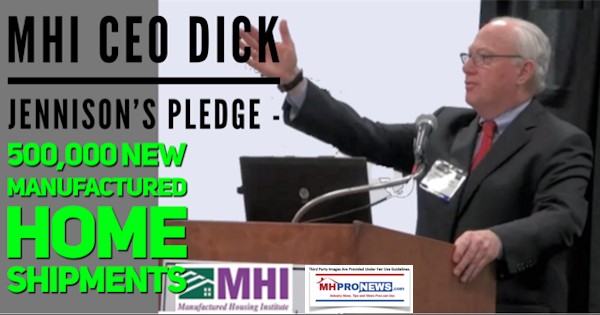
The flight from urban areas like Los Angeles and New York, and other trends all point to far higher potential for manufactured housing than is currently in evidence.

It remains to be seen if new or current investors and business leaders will decide to refocus on potential and make the kind of effort like Legacy’s, surpass it, or if the ‘merger and acquisition’ mantra that depends upon slow to no growth will continue from the so-called ‘leaders’ at MHI.
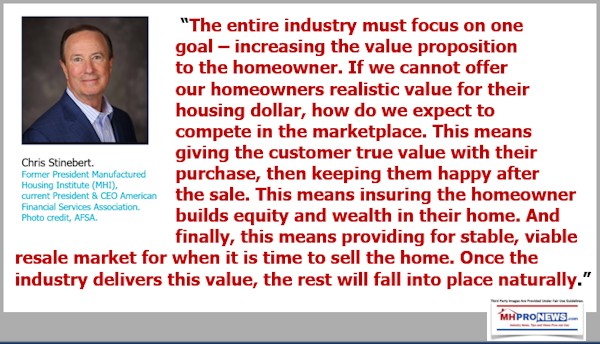
Every challenge that the industry faces has an common-sense answer based upon existing federal laws that favor the industry as well as years of third-party evidence that supports the rationale for manufactured housing doing far better than it has been in the Berkshire era.
MHProNews will continue to spotlight various industry data, drivers, and drags as they develop.
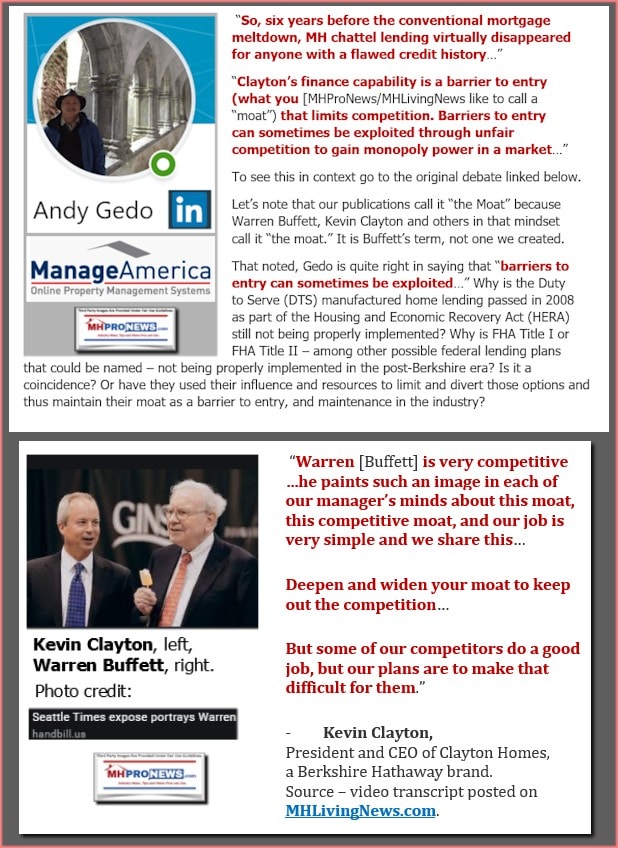


There is always more to read and more to come. Stay tuned with the runaway number one source for authentic “News through the lens of manufactured homes and factory-built housing” © where “We Provide, You Decide.” © ## (Affordable housing, manufactured homes, reports, fact-checks, analysis, and commentary. Third-party images or content are provided under fair use guidelines for media.) (See Related Reports, further below. Text/image boxes often are hot-linked to other reports that can be access by clicking on them.)

By L.A. “Tony” Kovach – for MHProNews.com.
Tony earned a journalism scholarship and earned numerous awards in history and in manufactured housing.
For example, he earned the prestigious Lottinville Award in history from the University of Oklahoma, where he studied history and business management. He’s a managing member and co-founder of LifeStyle Factory Homes, LLC, the parent company to MHProNews, and MHLivingNews.com.
This article reflects the LLC’s and/or the writer’s position, and may or may not reflect the views of sponsors or supporters.
Connect on LinkedIn: http://www.linkedin.com/in/latonykovach
Related References:
The text/image boxes below are linked to other reports, which can be accessed by clicking on them.



